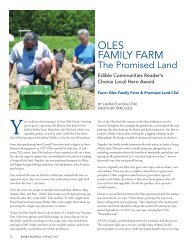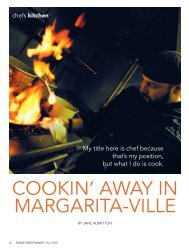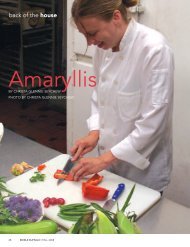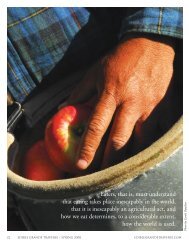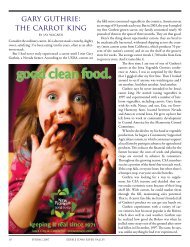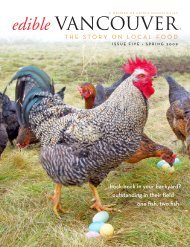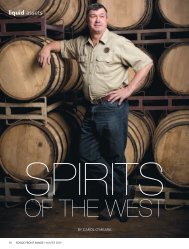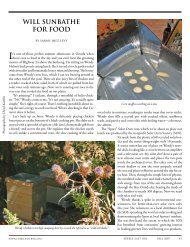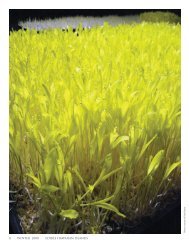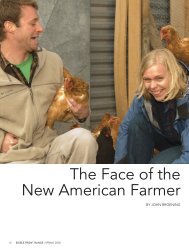Blueberry Wine - Edible Communities
Blueberry Wine - Edible Communities
Blueberry Wine - Edible Communities
You also want an ePaper? Increase the reach of your titles
YUMPU automatically turns print PDFs into web optimized ePapers that Google loves.
liquid assets<br />
<strong>Blueberry</strong><br />
<strong>Wine</strong><br />
TAN CHILDS<br />
WINERY<br />
BY KATHLEEN KELLOGG<br />
PHOTOS BY CAROLE TOPALIAN<br />
12 EDIBLE BUFFALO | SUMMER 2008
Tan Childs Farm and <strong>Wine</strong>ry is<br />
an oasis along the dusty and<br />
sometimes overgrown path<br />
linking Western New York’s truly local liquid<br />
assets. This fledgling estate winery is Cattaraugus<br />
County’s only winery and is situated<br />
midway between the Lake Erie and Finger<br />
Lakes plantations, on Cooper Hill in<br />
Humphrey and overlooking the southern<br />
sweep of the Enchanted Mountains. It is not<br />
listed as a stop on a tourist’s wine trail because<br />
this winery is staking its reputation not<br />
on grapes, but on “the best” blueberries.<br />
While a few wild blueberry plants were established<br />
before the Childs family came to<br />
Cooper Hill in the 1980s, owners Peter and<br />
Rita Childs have gradually introduced other<br />
varieties to the rows of bushes that stretch like<br />
vineyards across their mountaintop property.<br />
These are sustainably cultivated at the farm on<br />
Cooper Hill, to take advantage of the unique<br />
acidic soil chemistry rarely found elsewhere.<br />
The soil is moist enough and uniformly highacid<br />
to support blueberries without extensive<br />
soil amendments because Cooper Hill escaped<br />
the churning effect of the glaciers as they bypassed<br />
the hilltop farm. These well-manicured<br />
rows are cultivated to please the palate of ordinary<br />
folks who enjoy their fruit fermented<br />
and poured into a glass, as well as the taster<br />
schooled in the viniferous tradition but seeking<br />
a new and refreshing experience.<br />
Tan Childs <strong>Wine</strong>ry owners Peter and Rita<br />
Childs have nurtured the four decades-old<br />
fruit wine tradition from the family’s unlikely<br />
homegrown roots in a South Buffalo back<br />
yard. Peter picked up the rudiments of hobby<br />
winemaking there in his youth, harvesting<br />
wild dandelion, elderberry and raspberry<br />
through the seasons for his father, Bob, a<br />
home hobbyist who shared his skills with his<br />
children and his friends.<br />
Bob Childs and his wife Audrey followed<br />
their passion for berries into retirement in the<br />
1980’s, leading their family to the 2,250 feetelevation<br />
farm where they found wild blueberries<br />
growing back in 1965. Today the<br />
winery is the new neighbor next door to Bob<br />
Childs’ now-bustling U-Pick Childs <strong>Blueberry</strong><br />
Farm. Both enterprises attract visitors<br />
who are drawn from the family’s successful<br />
farmers market stands.<br />
When Peter and Rita married in 2002 they<br />
launched their five-acre winery, merging their<br />
agricultural heritage and joining their old<br />
family names—Tan comes from Rita’s Chinese<br />
ancestry—to create the mountain winery label<br />
and the symbolic raised glasses held by a<br />
Chinese farmer and an American cowboy on<br />
horseback. They strive for quality in the operation<br />
that they want to keep small for the time<br />
being. The hand-picked pesticide-free blueberries<br />
undergo a two-stage fermentation<br />
process for wine-making that enhances their<br />
natural antioxidants and free radical protection.<br />
The fermentation begins in the blueberry<br />
skin and continues in Peter Childs’ cellar<br />
where it is aged in 212-gallon stainless steel<br />
drums. This juice is then strained and aged for<br />
one year before it is marketed.<br />
When asked what is the best way to drink the<br />
wine, Childs says at first, it should be viewed<br />
as an adventure and people should experiment,<br />
but then he hefts an imaginary jug<br />
over his shoulder, a gesture that speaks<br />
volumes about his philosophy of making a<br />
wine that appeals to everyone. While he<br />
admits the blueberries that are sold at the<br />
farmers markets are the same ones that go<br />
into his wines, he says he’d like to keep the<br />
secret of which varieties make the best bottles<br />
of wine.<br />
“They say ‘No wine before it’s time,’ and<br />
that’s true of fruit too,” said Peter, who subscribes<br />
to a pioneering spirit but has intentionally<br />
avoided the economic pitfalls of “real<br />
farming” and donned the mantle of “gentleman<br />
farmer.” He has studied the scholarly<br />
research into the fruit’s health-boosting, agedefying<br />
antioxidants and anti-inflammatory<br />
properties, and he welcomes input from scientists<br />
who have visited Cooper Hill to study<br />
the soils. The family regularly tests plant foliage<br />
and applies any recommended mineral<br />
supplements to the soil, following strict<br />
timing in the application of integrated pesticides<br />
that occur well before or after harvest.<br />
“It’s like sustainable forestry. We try to leave<br />
the land better than when we started. That is<br />
not included in the definition of organic and<br />
you can destroy the soil with organic<br />
treatment,” said Childs. “In theory a good<br />
farmer wants to be farming today and also<br />
In theory a good farmer wants to be<br />
farming today and also next year.<br />
You can’t do that with heavy chemicals<br />
and pesticides.<br />
next year. You can’t do that with heavy chemicals<br />
and pesticides. Good farmers don’t want<br />
to use them.”<br />
The winery markets only a few hundred<br />
bottles of semi-dry and semi-sweet blueberry<br />
and elderberry wines, an artisan effort for a<br />
relatively few appreciative customers who he<br />
said have begun to return each year as a dedicated<br />
cult following.<br />
As Peter Childs leads a lesson in tasting, it’s<br />
not hard to see why a proper sip, rolled<br />
slowly over the tongue, can lead to membership<br />
in that cult. The berry’s slight acidity<br />
will open the taste buds and prepare them<br />
for food, so anything will taste better, he advises.<br />
But the table wine’s tingling and the<br />
changing flavors—the same “complexity”<br />
that sold cases of the stuff to a liquor store<br />
in Saratoga Springs—are unexpected. Even<br />
more complex—and surprising—is the dis-<br />
EDIBLE BUFFALO | SUMMER 2008 13
tinct sensation following a sip of the semi-sweet blueberry<br />
wine: it’s the fleeting explosive aftertaste of biting into a juicy<br />
ripe blueberry.<br />
The production and direct marketing efforts are purposely<br />
limited to maintain quality control, with sales managed by extended<br />
family members and trusted agents at a handful of farm<br />
markets. The wines are also sold to a select group of liquor<br />
stores around the region, while about ten cases a year are sold<br />
next door at the Child’s <strong>Blueberry</strong> Farm gift shop that is frequented<br />
by the throngs of visitors who come each July and<br />
August to pick their own fresh blueberries. The winery’s colorful<br />
Internet site, www.tanchilds.com, is an easily-accessible<br />
purchase outlet for customers who can’t visit the winery or one<br />
of the farmers markets that carry their products. These markets<br />
include North Tonawanda Farmers Market, East Aurora,<br />
Hamburg, Clarence, Downtown Buffalo, and the Rochester<br />
Public Market.<br />
Cattaraugus County’s pockets of acidic soils help other blueberry<br />
growers supply the growing legion of fans of this sweet blue fruit.<br />
Childs Blueberries is one of seven U-pick blueberry farms open<br />
to the public, but may be the only one with its own winery. eB<br />
Kathy Kellogg is a freelancer and gentlewoman farmer in Cattaraugus<br />
County. She finally found a good reason to plant her first<br />
two rows of blueberry bushes this spring.<br />
Cattaraugus County<br />
U-Pick <strong>Blueberry</strong> Farms<br />
<strong>Blueberry</strong> Hill Farm & Greenhouse<br />
10016 Allegany Rd., South Dayton 716-532-2920<br />
<strong>Blueberry</strong> Meadows<br />
Rowe Ave., Westons Mills 716-373-2865<br />
Burdick Blueberries, Inc.<br />
8267 Thompson Rd., East Otto 716-257-9760 or 1-800-642-4245<br />
Camp’s Blueberries<br />
67 Larkin St., Randolph 716-358-6422<br />
Child’s Blueberries<br />
3207 Cooper Hill Rd., Humphrey 716-557-2529<br />
Pepper’s Blueberries<br />
3370 Bear Creek Rd., Franklinville 716-676-2469<br />
Shadbush Farm Blueberries<br />
2430 Ten Mile Rd., Allegany 716-373-0301<br />
14 EDIBLE BUFFALO | SUMMER 2008



